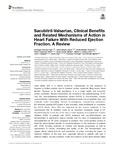Sacubitril-valsartan, clinical benefits and related mechanisms of action in heart failure with reduced ejection fraction: a review

Ver/
Use este enlace para citar
http://hdl.handle.net/2183/37181
A non ser que se indique outra cousa, a licenza do ítem descríbese como Creative Commons Attribution 4.0 International License (CC-BY 4.0)
Coleccións
- Investigación (FCS) [1293]
Metadatos
Mostrar o rexistro completo do ítemTítulo
Sacubitril-valsartan, clinical benefits and related mechanisms of action in heart failure with reduced ejection fraction: a reviewAutor(es)
Data
2021-11-11Cita bibliográfica
Pascual-Figal D, Bayés-Genis A, Beltrán-Troncoso P, Caravaca-Pérez P, Conde-Martel A, Crespo-Leiro MG, Delgado JF, Díez J, Formiga F, Manito N. Sacubitril-valsartan, clinical benefits and related mechanisms of action in heart failure with reduced ejection fraction: a review. Front Cardiovasc Med. 2021 Nov 11;8:754499.
Resumo
[Abstract] Heart failure (HF) is a clinical syndrome characterized by the presence of dyspnea or limited exertion due to impaired cardiac ventricular filling and/or blood ejection. Because of its high prevalence, it is a major health and economic burden worldwide. Several mechanisms are involved in the pathophysiology of HF. First, the renin-angiotensin-aldosterone system (RAAS) is over-activated, causing vasoconstriction, hypertension, elevated aldosterone levels and sympathetic tone, and eventually cardiac remodeling. Second, an endogenous compensatory mechanism, the natriuretic peptide (NP) system is also activated, albeit insufficiently to counteract the RAAS effects. Since NPs are degraded by the enzyme neprilysin, it was hypothesized that its inhibition could be an important therapeutic target in HF. Sacubitril/valsartan is the first of the class of dual neprilysin and angiotensin receptor inhibitors (ARNI). In patients with HFrEF, treatment with sacubitril/valsartan has demonstrated to significantly reduce mortality and the rates of hospitalization and rehospitalization for HF when compared to enalapril. This communication reviews in detail the demonstrated benefits of sacubitril/valsartan in the treatment of patients with HFrEF, including reduction of mortality and disease progression as well as improvement in cardiac remodeling and quality of life. The hemodynamic and organic effects arising from its dual mechanism of action, including the impact of neprilysin inhibition at the renal level, especially relevant in patients with type 2 diabetes mellitus, are also reviewed. Finally, the evidence on the demonstrated safety and tolerability profile of sacubitril/valsartan in the different subpopulations studied has been compiled. The review of this evidence, together with the recommendations of the latest clinical guidelines, position sacubitril/valsartan as a fundamental pillar in the treatment of patients with HFrEF.
Palabras chave
ARNI
Heart failure
Heart failure with reduced ejection fraction
Neprilysin inhibition
Sacubitril/valsartan
Heart failure
Heart failure with reduced ejection fraction
Neprilysin inhibition
Sacubitril/valsartan
Descrición
Review
Versión do editor
Dereitos
Creative Commons Attribution 4.0 International License (CC-BY 4.0)
ISSN
2297-055X






